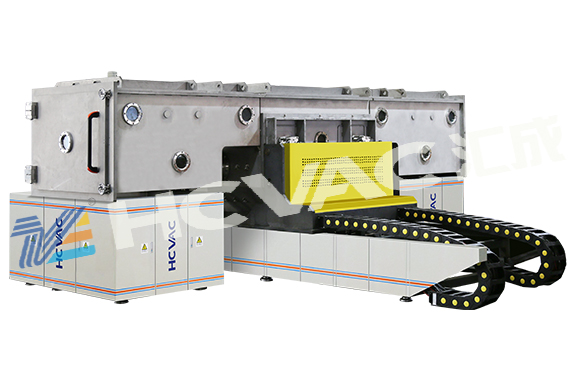The transformation and use of the vacuum coating machine also uses a 5450mm resistance heating evaporation coating machine with a vacuum chamber for the transformation, and retains the original evaporation device. Built-in DC magnetron sputtering target. A certain shape of neodymium iron boron permanent magnets are arranged inside the target body, and cooling water is passed through. The measured magnetic field intensity in the sputtering area of the target surface is 450 Gauss. The cooling water is introduced into the vacuum chamber through the spare hole at the bottom of the vacuum chamber of the coating machine, and a special water pipe joint has been developed so that the target and the cooling water pipe can be reliably sealed and connected without causing a short circuit. A device for heating and baking the substrate is installed in the vacuum chamber, and both the baking power supply and the sputtering power supply are introduced from a spare hole on the bottom plate of the vacuum chamber of the coating machine. The substrate holder and baffle for sputtering coating are vertically installed on the rotating rim of the evaporation coating substrate holder. When pre-sputtering, the baffle is located on the opposite side of the target, and during sputtering, the original substrate rotating power supply of the evaporation table is turned on, so that the sputtering substrate holder faces the target and rotates around the sputtering target. The evaporation and sputtering isolation plate separates the original vacuum coating chamber into two coating areas on the left and right, without affecting each other. The setting of the gas filling system is the same as the modification of the coating machine of the external magnetron sputtering target. After the equipment is modified as described above, since the substrate can rotate around the target during sputter coating, a large area and good uniformity film can be prepared.

Evaporation and sputter coating can also be carried out in the same teaching experiment. For example, in a vacuum brass plating experiment, place the sputtering substrate holder on the opposite side of the target before evaporation to prevent contamination of the sputtering substrate during evaporation. After finishing the evaporation, rotate the pre-sputtering baffle to the opposite side of the target, perform pre-sputtering under PAr=015Pa and sputtering power of 13002000W, and then turn on the rotating mechanism for sputtering coating under the rotation of the substrate. Students can intuitively realize that the decomposition of the alloy evaporation will cause the delamination of the film, and the sputtering coating can basically make the composition of the sputtering film consistent with the composition of the sputtering target.
(1) By installing external magnetron sputtering target and built-in magnetron sputtering target, the vacuum evaporation coating machine has been successfully modified, and the functions of the original coating machine have been increased, so that it can satisfy both evaporation coating and sputtering. The requirements of shoot coating have improved the equipment and the quality of film preparation, and greatly increased the range of film that can be plated. We used this modified coating machine to prepare and research the iso-dielectric film. It provides experimental conditions for scientific research, postgraduate project experiments, and undergraduate graduation projects.
(2) The reformed
vacuum coating machine has been used to conduct several teaching experiments for undergraduates, achieving the experimental purpose of enabling students to understand and master the two types of coating processes, evaporation and sputtering, and deepen students’ perceptual knowledge and consolidate Theoretical knowledge. At the same time, the extensive application of sputtering coatings in the fields of microelectronics, optoelectronics, and display technology has greatly increased students' enthusiasm for this experiment, and the effect of the experiment has been significantly improved.



